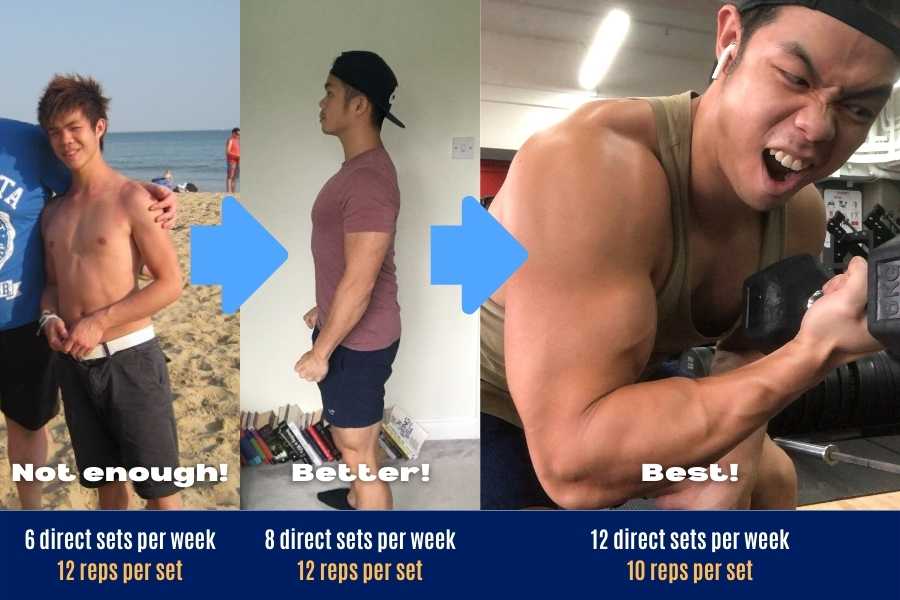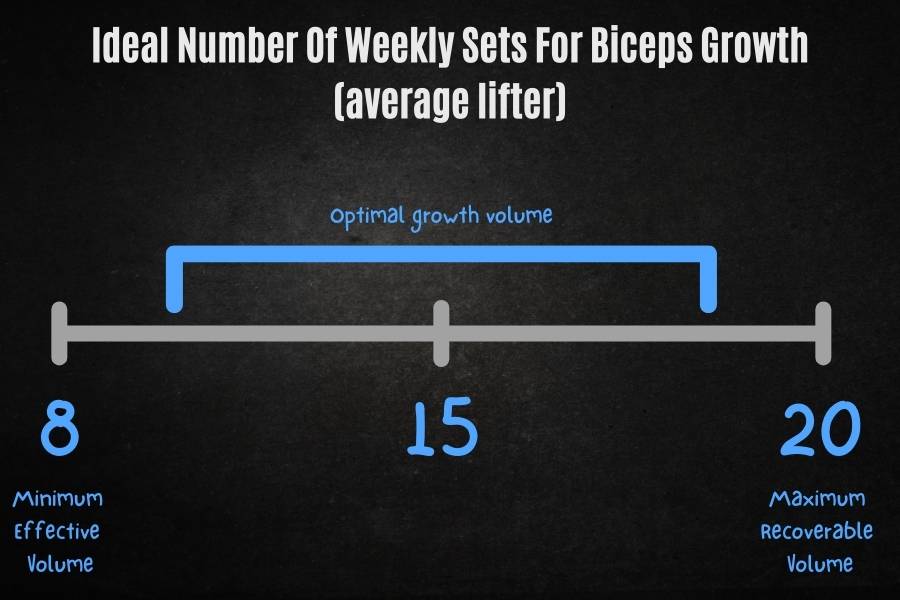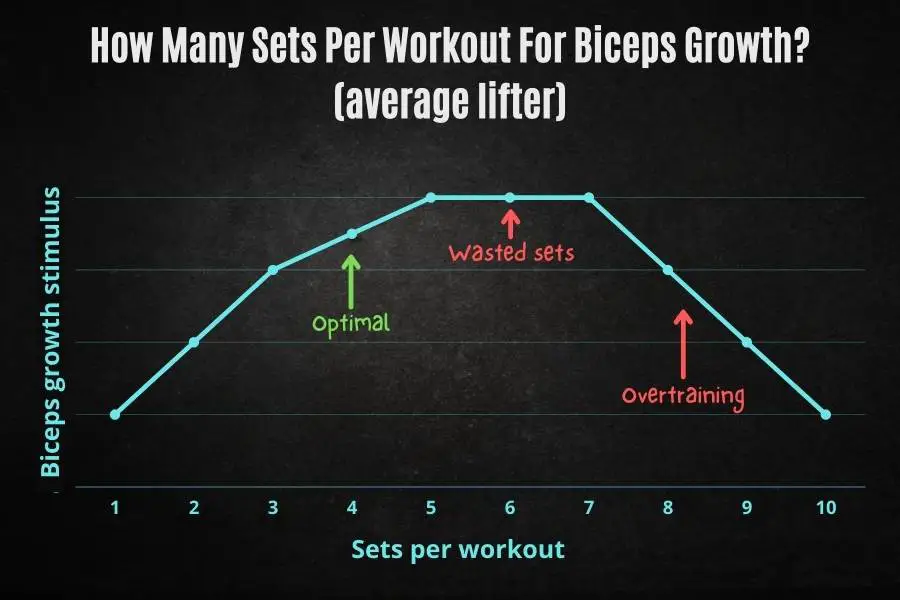I used to be a skinny guy- and I clearly remember the frustration of spending months doing dumbbell curls with no results to show. This post explains the optimum number of sets and reps you should do to get bigger biceps.
The biceps should receive 10-20 direct sets per week for optimal growth. In most training splits, this requires 3-6 sets to be completed per workout. Furthermore, each set should be performed in the 8-20 rep range using a weight that challenges the user.
In hindsight, my lack of results was because I undershot my total weekly training volume. In other words, I wasn’t performing enough sets and working in the wrong rep range.
Below, I’ll share exactly what I changed to blow up my arms!

- Key Takeaways
- Optimal Number Of Biceps Sets Per Week
- Why The 10-20 Set Range Is Effective
- Optimal Number Of Sets Per Bicep Workout
- How Many Sets Are Too Many For Biceps?
- Case Study: Are 6 Sets Too Much Or Not Enough?
- Situation 1: Undertraining With 6 Sets Per Week
- Situation 2: Overtraining With 6 Sets Per Week
- The Rule Of Halves For Direct And Indirect Biceps Sets
- Optimal Number Of Reps Per Bicep Set
- How Many Reps Are Too Much For Biceps Growth?
- Conclusion
Key Takeaways
- Beginners and intermediates should aim for 10-15 direct bicep sets per week.
- Advanced lifters usually aim for 15-20 direct bicep sets.
- This equates to around 3-6 biceps sets per workout for a 3 to 5-day training split.
- 8-20 reps per set are ideal for biceps hypertrophy.
- Use a weight that challenges you for each set.
Optimal Number Of Biceps Sets Per Week
Not performing a sufficient training volume (i.e. sets, reps, weight, and frequency) is one of the biggest bicep-building mistakes that beginners make.
A total of 10-20 direct sets per week of curling exercises are ideal for arm growth. But this is a large spectrum. So is it better to hit your biceps with 10 or 20 sets? Or in between?
The answer depends largely on your training level and program, as follows:
| Training Experience | Recommended Weekly Sets |
|---|---|
| Pro | 20+ |
| Advanced | 15-20 |
| Intermediate | 12-15 |
| Beginner | 8-12 |
1) Pro Bodybuilders
Professional bodybuilders like Chris Bumstead (Mr Olympia) commonly work the biceps with 10-12 direct sets per week with different types of curl variations.
Their programs also invariably include a lot of compound pulling movements like dumbbell rows (link for weight standards) and lat pulldowns which work the biceps with indirect sets.
Factoring in the indirect sets, advanced lifters usually complete close to 20 total direct sets per week (sometimes even more).
2) Advanced
People with 3+ years of consistent arm training experience usually work their biceps with a combination of direct and indirect exercises.
Accounting for these direct and indirect movements, their biceps usually receive somewhere between 15-20 total weekly sets (sometimes less depending on the program and primary goal).
This is sufficient for an advanced lifter to grow their biceps.
3) Intermediate
People with up to 2 years of consistent arm training on their belts should aim to complete 12-15 total weekly sets of direct biceps exercises like dumbbell curls (link for weight standards).
This can even be reduced to around 8-12 total weekly direct sets if you are also performing a lot of compound pulling in your workout program.
4) Beginner
As a complete newbie, aim for 8-12 total weekly sets of direct bicep exercises to start (or 6-8 direct sets if you’re also doing indirect compound pulling).
Stick to the lower end of the spectrum if it’s your first time training, and move towards the upper end of the spectrum as you become stronger.
You can slowly increase the total number of weekly sets (as per the above recommendations) as you gain strength over time.
Why The 10-20 Set Range Is Effective

The overall aim of optimizing your weekly sets is to ensure you hit the biceps with enough work to increase arm size, but not so much that you overtrain.
Remember- muscles can only respond positively to a limited amount of sets within a certain timeframe. And once this threshold is crossed, you risk overtraining (which negatively impacts recovery and growth).
This threshold in turn varies depending on your current fitness level. But generally speaking, it lies within 10-20 weekly sets.
“Most lifters require 8 sets (minimum) of direct bicep work per week to promote hypertrophy. But the maximum recoverable volume for biceps is around 20 sets per week.”
Dr. Mike Israetelli, Renaissance Periodization.
Therefore, 10-20 sets per week are the ideal balance for hypertrophy and recovery across all training levels.
And you should factor in your personal training experience in order to determine exactly where you should lie on the above spectrum.
Optimal Number Of Sets Per Bicep Workout

To reach 10-20 weekly biceps sets, the average lifter should aim to complete 3-6 direct biceps sets per workout.
The exact recommended number of sets per workout will vary depending on your training frequency (aka workout split) and the total weekly sets you are aiming for.
Thus, there are multiple ways to achieve the final 10-20 weekly sets.
For example, 12 total weekly biceps sets could be achieved in multiple ways as follows below.
Method 1:
| Direct biceps sets per workout | 4 |
| Number of workouts per week | 3 |
| Total weekly biceps sets completed: | 12 |
Method 2:
| Direct biceps sets per workout | 6 |
| Number of workouts per week | 2 |
| Total weekly biceps sets completed: | 12 |
In both examples, a weekly target of 12 total sets is achieved. But method 1 requires you to do 4 sets per workout and method 2 requires you complete 6 sets per workout.
Thus, the main variable here is the number of sets per workout and the number of workouts per week.
Also important- capping each workout to 6 sets (max) helps you avoid so-called “wasted sets”.
This phenomenon was coined after studies suggest that exceeding 5 sets per muscle per day does not confer any more added benefits to your hypertrophy goal.
“Performing more than 5 sets per exercise does not produce greater gains in muscle strength and size.”
Hackett et Al. 2018
Thus, working with 3-6 direct sets (max) per workout can help you:
- Stay in the optimal hypertrophy zone for a given workout.
- Reach your total weekly target sets.
- Minimize the risk of time wasted on sets that do not give you hypertrophy benefits.
How Many Sets Are Too Many For Biceps?
Taking everything into consideration, here’s a table to help you quickly identify whether your current training volume is optimal or insufficient for biceps hypertrophy:
| Number Of Biceps Sets | Per Week | Per Workout |
|---|---|---|
| 1 | Not enough (undertraining) | Not enough (undertraining) |
| 2 | Not enough (undertraining) | Barely enough for growth |
| 3 | Not enough (undertraining) | Ideal for maximal growth |
| 4 | Not enough (undertraining) | Ideal for maximal growth |
| 5 | Not enough (undertraining) | Ideal for maximal growth |
| 6 | Barely enough for growth | Ideal for maximal growth |
| 7 | Barely enough for growth | Too much (overtraining) |
| 8 | Barely enough for growth | Too much (overtraining) |
| 9 | Barely enough for growth | Too much (overtraining) |
| 10 | Barely enough for growth | Too much (overtraining) |
| 11-15 | Ideal for maximal growth | Too much (overtraining) |
| 16-20 | Ideal for maximal growth | Too much (overtraining) |
| 20+ | Too much (overtraining) | Too much (overtraining) |
Note: these are just general recommendations based on all fitness levels (beginner to advanced).
In practice, you should decide how many sets to allocate for biceps training according to your own training experience and program (see my case study example in the next section).
Beginners should stay on the lower end of the “ideal for maximal growth” range, while more advanced lifters can choose to stay on the upper end.
Are you a skinny beginner looking to get jacked? You can check out my complete home workout plan!
Case Study: Are 6 Sets Too Much Or Not Enough?
I’ll use my own personal experience as a case study to highlight the importance of optimizing sets according to your training program.
This is essential because an effective workout program should work your biceps with indirect sets from compound pulling exercises like pull-ups and rows, in addition to direct sets from movements like curls.
And if you don\’t factor in the indirect sets, then you may end up over/undertraining as I did. You can see below how that can happen.
Situation 1: Undertraining With 6 Sets Per Week

During my early training days, I completed ~6 sets of curls per week (without doing any other exercise) and found my arms just would not get bigger.
In retrospect, it was because I wasn’t doing enough sets and also using the wrong dumbbell weight for biceps optimal growth
So I increased the weight and also included ~5 sets of rows and pull-ups (each) which contributed an additional 10 indirect sets.
A total of 6 direct sets + 10 indirect sets helped me see much better results in terms of biceps growth.
Situation 2: Overtraining With 6 Sets Per Week

This is the opposite of situation 1.
Doing 6 direct sets of bicep curls per week can quickly turn from undertraining to overtraining if you’re also doing a lot of compound pulling on the side.
This is also something I’ve personally experienced in the past.
In an effort to get big fast, I increased to 15 sets of pull-up and row variations per week (each).
All the while, I stuck to my 6 weekly sets of dumbbell curls.
6 direct sets + 30 indirect sets meant that my biceps always felt sore and they never felt “fresh” for each workout.
As a result, I began struggling with the same dumbbell curl weight that I had no issue with lifting before, and my gains stagnated.
The Rule Of Halves For Direct And Indirect Biceps Sets
It can be tricky to determine exactly how many sets your biceps are receiving when you’re doing a combination of direct (curls etc) and indirect movements (rows etc).
I recommend applying the rule of halves- 2 indirect sets contribute to 1 direct set.
As an example, 10 sets of bicep work per week could look like this when accounting for direct and indirect sets:
| Exercise | Working Sets | Direct Sets Contributed To Biceps |
|---|---|---|
| Pull-ups | 5 | 2.5 |
| Dumbbell row | 5 | 2.5 |
| Dumbbell curl | 5 | 5 |
| Total: | 15 | 10 |
This is an easy way to account for each and every set that your biceps receives in your workout program.
Optimal Number Of Reps Per Bicep Set

Generally speaking, performing 8-20 repetitions per set is ideal for maximizing biceps size.
This is the recommended rep range for muscle hypertrophy. However, some people respond better to higher reps whilst others like to work in lower rep ranges.
I’ve always found the lower end of the spectrum (8 to 10 reps per set) to be the sweet spot for hypertrophy in smaller muscles like the biceps and triceps.
This rep range for arms is low enough to allow heavy loads to be lifted but not so high that your cardiovascular system becomes taxed.
Furthermore, doing 8-12 reps (falls within the 8-20 range) per set is the common consensus for building optimal muscle strength and size.
Interestingly, there’s also a common train of thought (particularly amongst bodybuilders) that advocates lifting higher reps in the 15-20 range (sometimes up to 30 reps) using a lighter weight.
In this scenario, they would typically work their biceps in the 8 to 12-rep range at the start of a workout and finish the biceps with isolation-type movements done in the 15-rep range (or more).
“A slightly higher rep range will maximize your biceps pump.”
Bill Geiger, Bodybuilding.com
Having tried this, I did not feel it to be the best for hypertrophy because the cardiovascular system kicks in before the biceps truly become fatigued.
How Many Reps Are Too Much For Biceps Growth?
The biceps can be effectively trained using 6 to 30 reps per set, and even more.
The most important consideration is not the number of reps per se, but lifting a weight that fatigues the target muscle within the last few reps in a set (you can check out my other article to learn how to choose the correct dumbbell weight for arms).
In support of this, a scientific study found that muscular hypertrophy can be achieved using both high and low rep ranges as long as the muscle is trained to failure.
As I said before, everyone is different. So find a rep range that works for you. Just make sure you lift a sufficient amount of weight!

I would always recommend a beginner start with 10 reps and adjust from there. This is in line with 80% of respondents in this Reddit thread who said they usually work in the 6-12 rep range for biceps exercises.
Conclusion
Choosing the ideal number of sets and reps for optimal biceps growth can be challenging for a beginner. But I’ve given you an insight into what to aim for:
- 10-20 total direct sets per week.
- 3-6 direct sets per workout.
- 8-20 reps per set using a sufficient weight.
This training volume helped me transform my skinny arms. I encourage beginners to start by following a similar volume (starting on the lower end of each spectrum) and increase as you get stronger and bigger!
You may also be interested in the downloadable Kalibre Blueprint PDF which details exactly how I gained 40lbs of lean muscle (it’s 100% free!). It details the exact exercises and nutrition (with printables) I used to go from skinny to ripped!


